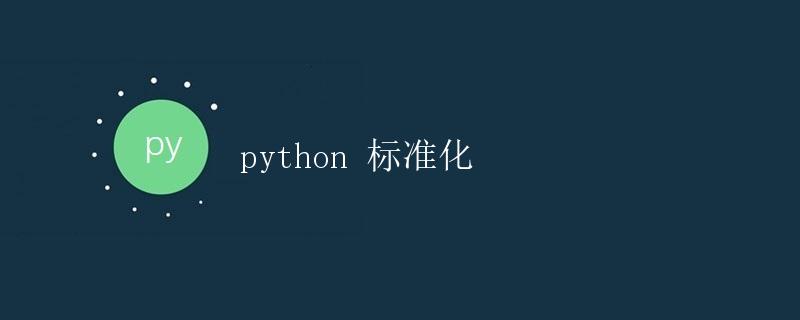Python 标准化

1. 介绍
Python 是一种功能强大的编程语言,它提供了许多标准库和工具,可以帮助我们更高效地完成任务。其中一个重要的库就是标准化库(Standard Library),它包含了很多有用的模块和函数,可以用于各种编程任务。
本文将介绍 Python 标准化库的一些常用模块和函数,以及它们在实际开发中的用法。我们将涵盖以下几个方面:
- 文本处理
- 数据结构和算法
- 文件操作
- 网络和网页开发
- 时间和日期处理
- 数据库操作
- 多线程和并发编程
2. 文本处理
在许多应用程序中,文本处理是一个常见的任务。Python 提供了一些模块来处理字符串和文本数据。
2.1 字符串操作
在 Python 中,字符串是不可变的,这意味着我们不能直接修改字符串的内容。但是,Python 提供了一些函数和方法来操作字符串。以下是一些常用的字符串操作函数:
len(str): 返回字符串的长度。str.lower(): 将字符串转换为小写。str.upper(): 将字符串转换为大写。str.strip(): 去除字符串两端的空白字符。str.split(sep): 使用指定的分隔符来拆分字符串。str.join(iterable): 将可迭代对象中的字符串连接起来。str.replace(old, new): 将字符串中的旧字符串替换为新字符串。
以下是使用这些函数的示例代码:
str = "Hello, World!"
print(len(str)) # 输出: 13
print(str.lower()) # 输出: hello, world!
print(str.upper()) # 输出: HELLO, WORLD!
print(str.strip()) # 输出: Hello, World!
print(str.split(",")) # 输出: ['Hello', ' World!']
print("-".join(str)) # 输出: H-e-l-l-o-,- -W-o-r-l-d-!
print(str.replace("Hello", "Hi")) # 输出: Hi, World!
2.2 正则表达式
正则表达式是一种强大的文本匹配工具,可以用于查找和替换特定模式的文本。Python 使用 re 模块提供了正则表达式的支持。
以下是一些常用的正则表达式函数和方法:
re.match(pattern, string): 从字符串的开头开始匹配模式。re.search(pattern, string): 在字符串中搜索并返回第一个匹配的模式。re.findall(pattern, string): 返回字符串中所有匹配的模式。re.sub(pattern, repl, string): 将字符串中匹配的模式替换为指定的字符串。
以下是使用正则表达式的示例代码:
import re
pattern = r"\b[A-Za-z]+\b" # 匹配一个或多个单词字符
string = "Hello, World! This is a text."
print(re.match(pattern, string)) # 输出: <re.Match object; span=(0, 5), match='Hello'>
print(re.search(pattern, string)) # 输出: <re.Match object; span=(0, 5), match='Hello'>
print(re.findall(pattern, string)) # 输出: ['Hello', 'World', 'This', 'is', 'a', 'text']
print(re.sub(pattern, "Hi", string)) # 输出: Hi, Hi! Hi Hi Hi Hi Hi.
3. 数据结构和算法
Python 提供了许多数据结构和算法的实现,可以帮助我们更好地处理和组织数据。
3.1 列表、元组和字典
列表(List)是一种可变的有序序列,元组(Tuple)是一种不可变的有序序列,字典(Dictionary)是一种键值对的无序集合。
以下是列表、元组和字典的一些常用操作:
- 列表操作:
list.append(elem): 在列表末尾添加元素。list.pop(index): 移除并返回指定位置的元素。list.sort(): 对列表进行排序。
- 元组操作:
- 不可变,不能添加或移除元素。
- 可以通过索引来访问元素。
- 字典操作:
dict.keys(): 返回字典中所有的键。dict.values(): 返回字典中所有的值。dict.items(): 返回字典中所有的键值对。
以下是使用这些操作的示例代码:
# 列表操作
my_list = [1, 2, 3]
my_list.append(4)
print(my_list) # 输出: [1, 2, 3, 4]
my_list.pop(1)
print(my_list) # 输出: [1, 3, 4]
my_list.sort()
print(my_list) # 输出: [1, 3, 4]
# 元组操作
my_tuple = (1, 2, 3)
print(my_tuple[1]) # 输出: 2
# 字典操作
my_dict = {"name": "Alice", "age": 20}
print(my_dict.keys()) # 输出: dict_keys(['name', 'age'])
print(my_dict.values()) # 输出: dict_values(['Alice', 20])
print(my_dict.items()) # 输出: dict_items([('name', 'Alice'), ('age', 20)])
3.2 排序和查找算法
Python 提供了多种排序算法,例如冒泡排序、插入排序和快速排序等。同时,Python 还提供了一些查找算法,例如线性查找和二分查找。
以下是使用排序和查找算法的示例代码:
# 冒泡排序
def bubble_sort(arr):
n = len(arr)
for i in range(n):
for j in range(0, n-i-1):
if arr[j] > arr[j+1]:
arr[j], arr[j+1] = arr[j+1], arr[j]
my_list = [4, 2, 7, 1, 9]
bubble_sort(my_list)
print(my_list) # 输出: [1, 2, 4, 7, 9]
# 二分查找
def binary_search(arr, target):
low = 0
high = len(arr) - 1
while low <= high:
mid = (low + high) // 2
if arr[mid] == target:
return mid
elif arr[mid] < target:
low = mid + 1
else:
high = mid - 1
return -1
my_list = [1, 2, 4, 7, 9]
print(binary_search(my_list, 4)) # 输出: 2
print(binary_search(my_list, 6)) # 输出: -1
4. 文件操作
Python 提供了一些模块和函数,用于文件的读写和处理。
4.1 文件读写
使用内置的 open() 函数可以打开一个文件,并指定打开文件的模式(读取、写入、追加等)。以下是使用 open() 函数进行文件读写的示例代码:
# 以只读模式打开文件并读取内容
file = open("file.txt", "r")
content = file.read()
print(content)
file.close()
# 以写入模式打开文件并写入内容
file = open("file.txt", "w")
file.write("Hello, World!")
file.close()
# 以追加模式打开文件并在文件末尾添加内容
file = open("file.txt", "a")
file.write("This is a text.")
file.close()
4.2 文件处理
除了读写文件外,Python 还提供了一些用于处理文件的模块和函数。
os模块提供了一些与操作系统相关的函数,例如文件和目录的操作。shutil模块提供了一些高级的文件操作函数,例如复制、移动和删除文件。glob模块用于查找文件路径匹配特定模式的文件。
以下是使用这些模块和函数进行文件处理的示例代码:
import os
import shutil
import glob
# 使用 os 模块创建目录
os.mkdir("directory")
# 使用 shutil 模块复制文件
shutil.copy("file.txt", "directory/file_copy.txt")
# 使用 os 模块删除文件
os.remove("file.txt")
# 使用 glob 模块查找文件
file_list = glob.glob("directory/*.txt")
print(file_list) # 输出: ['directory/file_copy.txt']
5. 网络和网页开发
Python 提供了许多模块和库,用于与网络和网页进行交互和开发。
5.1 网络编程
使用 Python 的 socket 模块,我们可以创建服务器和客户端应用程序,进行网络通信。
以下是使用 socket 模块进行网络编程的示例代码:
import socket
# 创建服务器
server_socket = socket.socket(socket.AF_INET, socket.SOCK_STREAM)
server_socket.bind(("localhost", 1234))
server_socket.listen(1)
# 接受客户端连接
client_socket, address = server_socket.accept()
print("接收到来自客户端的连接:", address)
# 接收和发送消息
data = client_socket.recv(1024).decode()
print("接收到消息:", data)
client_socket.send("服务器返回消息".encode())
# 关闭连接
client_socket.close()
server_socket.close()
5.2 网页开发
Python 提供了一些库,用于开发和处理网页。
requests库用于向服务器发送 HTTP 请求,并获取响应。BeautifulSoup库用于解析和处理 HTML 或 XML 文件。flask框架是一个基于 Python 的 Web 框架,适用于开发简单的网页应用。
以下是使用这些库进行网页开发的示例代码:
import requests
from bs4 import BeautifulSoup
from flask import Flask, render_template
# 使用 requests 发送请求获取网页内容
response = requests.get("http://www.example.com")
# 使用 BeautifulSoup 解析网页内容
soup = BeautifulSoup(response.text, "html.parser")
title = soup.title.string
print(title)
# 使用 flask 创建网页应用
app = Flask(__name__)
@app.route("/")
def home():
return render_template("index.html", title=title)
if __name__ == "__main__":
app.run()
6. 时间和日期处理
Python 提供了 datetime 模块,用于处理日期和时间。
以下是使用 datetime 模块进行日期和时间处理的示例代码:
from datetime import datetime, timedelta
# 获取当前日期和时间
now = datetime.now()
print(now)
# 格式化日期和时间
formatted = now.strftime("%Y-%m-%d %H:%M:%S")
print(formatted)
# 计算日期和时间的差值
future = now + timedelta(days=7)
print(future)
duration = future - now
print(duration.days)
7. 数据库操作
Python 提供了许多库和模块,用于连接和操作各种关系型和非关系型数据库。
以下是使用 Python 操作 SQLite 数据库的示例代码:
import sqlite3
# 连接到数据库
conn = sqlite3.connect("mydb.db")
# 创建表
conn.execute("CREATE TABLE students (id INT, name TEXT, age INT)")
# 插入数据
conn.execute("INSERT INTO students (id, name, age) VALUES (1, 'Alice', 20)")
# 查询数据
cursor = conn.execute("SELECT * FROM students")
for row in cursor:
print(row)
# 关闭数据库连接
conn.close()
8. 多线程和并发编程
Python 提供了一些模块和工具,用于实现多线程和并发编程。
8.1 多线程编程
使用 Python 的 threading 模块,我们可以在一个程序中同时执行多个线程,并实现并发的效果。
以下是一个使用多线程的示例代码:
import threading
# 定义一个线程任务
def print_numbers():
for i in range(1, 10):
print(i)
# 创建并启动线程
thread = threading.Thread(target=print_numbers)
thread.start()
# 主线程继续执行其他任务
print("Hello, World!")
8.2 并发编程
使用 Python 的 concurrent.futures 模块,我们可以使用多个进程或线程来并发执行多个任务。
以下是一个使用并发编程的示例代码:
import concurrent.futures
# 定义一个任务
def square(x):
return x ** 2
# 创建并发执行器
with concurrent.futures.ThreadPoolExecutor() as executor:
# 提交任务并获取结果
future1 = executor.submit(square, 5)
future2 = executor.submit(square, 10)
# 获取任务结果
result1 = future1.result()
result2 = future2.result()
# 打印结果
print(result1)
print(result2)
结论
Python 的标准化库为我们提供了许多功能强大的模块和函数,可以帮助我们更高效地完成各种编程任务。在本文中,我们介绍了一些常用的标准化模块和函数,涵盖了文本处理、数据结构和算法、文件操作、网络和网页开发、时间和日期处理、数据库操作以及多线程和并发编程。
 极客教程
极客教程